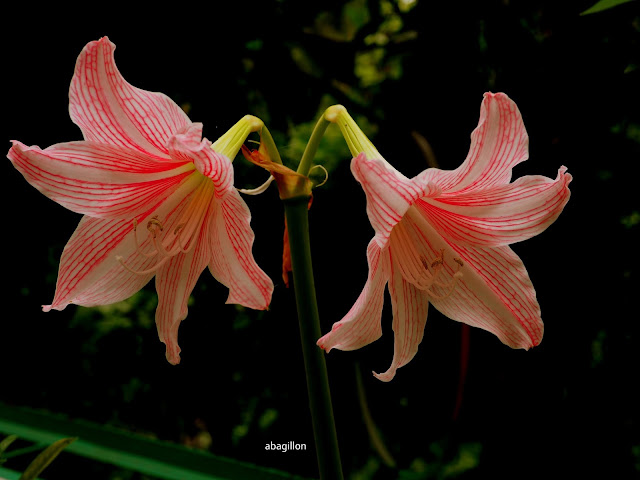Officially, we are still within our rainy season, but rain has already been dwindling. Our temperatures are at the lower 30Cs with Heat Index even higher than that, as if it is already at the height of the dry season. Climate change is manifesting so well with us, and El Nino fully aggravates it. At least our flowers and plants are still lingering with their flowers, unlike when they are in temperate zones, that cold front or frost will totally obliterate them in a few blows. So i am giving you our present garden status.
I am posting both my mother's biodiversity garden and my hoya garden.
It looks invasive but who cares, white is lovely, Alternanthera ficoidea 'Snow in the Mountain'.
We just trim them when time allows. You will see some invaders there too,
that green vine is a misguided sweet potato.
We just trim them when time allows. You will see some invaders there too,
that green vine is a misguided sweet potato.
Ixora coccinea never fails to show off, and is a favorite of the butterflies.
above is the wider angle shot of that area
Asystasia intrusa favorably hides a wire fence, serving also as its trellis
Crossandra infundibuliformis gets lovelier too during the rainy season
Alternanthera ficoidea 'Party Time'
Individual Flowers
a terete vanda remnant of an old hobby
we also have some roses
Chrysothemis pulchelia - we have a lot of this as it has an enlarged root that lies dormant during the dry season and ressurect again during the rainy season.
a lovely lily, Hippeastrum reticulatum, flowers all year unlike most of the hippeastrum that only flowers once a year
Artemisia scoparia, also lovely when in hedges, also favorite intoxicating potion by some butterflies
Duranta erecta
kamantigui or Impatiens balsamina. We have different colors before but it seems like only the violet and the whites remain with us now.
red Salvia
This Sanchezia speciosa is a new plant from our old mother plant which has been with us for several years now, allowed to grow fully during the wet season and hedged back before the end of the dry season
My Hoyas
GBBD is not complete without my hoyas, which has been occupying all my weekends. I started with a few species, but its addicting properties become so virulent that i now have a lot of species in my collection. This addiction is also contagious that i have friends now who are also deeply into it. Even my Facebook photos have its share of virulence, affecting some FB users who are not my former friends. Now they become my hoya friends. I still have many which are in bloom, but i intentionally refrain from posting them. They deserve another post.
Hoya diversifolia
Hoya buotii (purple)
Hoya buotii (yellow)
Hoya imperialis



















Beautiful!
ReplyDeleteHappy Garden Bloggers' Bloom Day!
You have so much blooming! The hoyas are just stunning, photos and flowers. Enjoy and thanks for sharing!
ReplyDeleteWow, that lily with the pink stripes through it is stunning!
ReplyDeleteEvery image you've shown here is full of health and vigor and beauty. What a beautiful place you live in! I remember seeing the Duranta at a garden center in Florida when I was there last year. It's a beauty--along with all the other incredible plants in your mother's and your own gardens. Happy GBBD!
ReplyDeleteWhat a treat to see so many vibrant flowers blooming in such rich colors.
ReplyDeleteIt is sooo nice to see the flowers and green as ours are gone... Michelle
ReplyDeleteYour flowers are still thriving well during this very wet season. Most of my shrubs look rather barren as the flowers are washed off under the heavy ddownfall.
ReplyDeleteWe just had our first seriously cold day (temperatures never got above freezing), which made it a good time to come over and enjoy your tropical flowers. I love that striped Hippeastrum. -Jean
ReplyDeleteSo beautiful all these colourful plants you can grow. The Duranta erecta looks very special to me. Hippeastrum reticulatum is a beauty too and flowering all year, I wonder if I can find this one here. Many of these plants are grown in huge glasshouses in our country, but they never can compare with the beauty of yours growing in a natural environment.
ReplyDelete